Timbre
[responsivevoice_button]
The Timbre of a sound is the term used to identify a sound’s ‘fingerprint‘ as it represents that quality that makes it unique from another sound. This is directly linked to the primary and secondary frequencies and their specific volumes. Each instrument will have its own volume settings that will give it it’s unique sound.
String instruments can have similar timbres as their sounds and construction are similar enough that they would share certain sound qualities. The same would apply to wind instruments, reed instruments, and percussion instruments. The various instrument families all have their own characteristics that allow us to recognize the family that any given instrument might belong to however timbre can go deeper than that as well.
The difference between a violin and an acoustic guitar for example is pretty obvious even though each instrument might be playing the same note, or have the same equalization settings. They both belong to the string family however one is played with a bow while another is plucked or played with a pick. Using a guitar pick on a violin for example will result in a very guitar-like sound just as using a bow on a guitar will sound much closer to a violin. Their body size and construction is different however, therefore each will still have a unique sound. The timbre is how you know that one instrument is audibly different from another.
It isn’t as easy to distinguish two violins from one another since they have similar timbres therefore it’s safe to say that the timbre is the overall expectation we have of an instrument’s sound. There may still be slight and perhaps even obvious differences between two violins since a slight variation of wood or even hardware (ie. tuning pegs or strings) can affect the instrument’s tone in an obvious way however the timbre is basically the overall sound of an instrument that allows you to recognize a particular sound as coming from a violin and not a cello, piano or guitar.
It is possible to actually modify the tone drastically enough to cause an instrument to no longer sound like it is expected to however if the instrument is no longer recognizable or modified in such a way that it would sound like a different instrument altogether, you can say that the timbre has been affected and the new sound is actually a different instrument. With modern technology for example, you can make a guitar sound like a violin, or an organ… in this case, while you are using a guitar as a means or tool to making music, the timbre of your resulting sound is of an organ, not a guitar.

Pun Of The Week
Blood War – Rambo
How to earn a black belt…

[responsivevoice_button]
A black belt in karate signifies that one has attained a very advanced skill level while a white belt indicates that you are a novice.
While the belt colour is a way to distinguish one person’s skill level from another, karate teaches that there’s is no white or black belt but rather simply a white belt that gets darker through time.
It is basically the same white belt that has simply darkened over time through the practice or routine of putting it on and taking it off.
Each level of darkness represents ‘experience’ and therefore signifying that one has gained more and more knowledge through practice, application, routine, repetition, study etc
A black belt therefore is not truly black but rather a much darker shade of the original white and although it appears to be black, it continues to darken further and further despite our inability to distinguish one level of darkness from another.
While two black belts appear equal to one another however, the precise level of experience is difficult to identify as one person might be stronger in some areas while another is stronger on other areas.
The goal is therefore not to have a black belt but rather to continuously keep darkening it with experience and knowledge even after it appears to have reached what we believe to be it’s darkest shade.

The Circle Of Fifths
My first gear
When I began playing guitar at 14 years old I didn’t have much knowledge (or money) to buy gear. I somehow knew I preferred the look of stratocasters because it was the closest thing to Eddie Van Halen’s guitar but I didn’t know much else about guitars, amps, or that effects even existed.
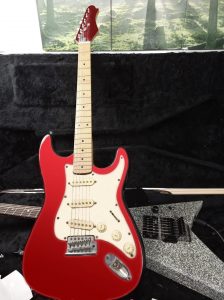
My first guitar was a cherry red strat with a white pickguard from a company called Rocko with an amplifier by the same name. I believe we paid $300 for both.
I haven’t been able to find an image of my amp online however here is an image of my first guitar. This is an actual image of ‘my’ guitar as it was taken by the person I sold it to. I did have to modify the color as the guitar had been painted since I sold it however it is the actual original guitar.
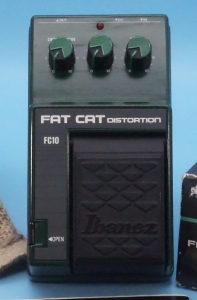
Once I started making some progress I did begin to understand the role of some guitar pedals so I purchased an Ibanez FC10 – FatCat distortion and the DOD FSB-75 Flanger pictured below:
When I turned 16 years old my parents gave me my first real guitar. It was a Kramer 600ST which I still own today. It had a Floyd Rose tremolo and a reversed headstock however I wasn’t fond of the headstock (because Eddie’s headstock was not reversed!!!) so I had it replaced with a 615ST neck before taking it home.
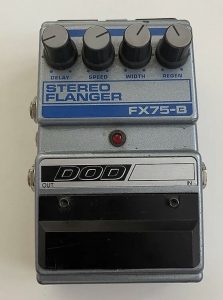
I also replaced my amp with a Fender Power Chorus which was super loud! I have literally never played the amp with a volume setting higher than 1.5.
I still own this solidstate monster however I’ve had to consider other options as it was simply too loud for home use.
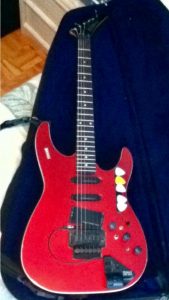
Since then, my guitar, amp, and pedal collection has grown as some of us seem to feel like we need to be ready for war when the time comes but I’ll get into other gear in other posts at some point.
The items listed above however are a big part of my early days, my musical journey as as every item also represented a new discovery, a new departure, and a new level of knowledge and experience.
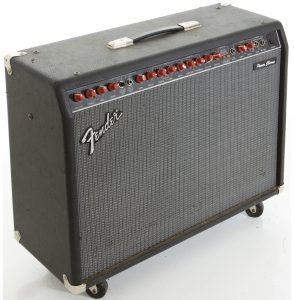
Island Time
Tone
[responsivevoice_button]
I coupled Tone with Width since I had already decided to place Pitch with Height however, once again, there is no reason to look at tone as something that is measured as width. The reason I am using length, width and height is to show that sound, like objects has different dimensions that make up it’s form. If you turn a box on it’s side for example, the height is now used to measure a different side, regardless of it’s actual measurement. It is however, a different measurement that helps us understand the dimensions of an object.
While Pitch describes the frequency at which the sound oscillates/vibrates, Tone refers to the quality of the sound itself. Therefore what pitch is to height, tone is to width in that it measures a different dimension or quality of a sound. Once we have established a pitch to focus on, we’ll want to describe what that pitch sounds like in terms of tone. Unfortunately Tone is also measured in frequencies therefore it can cause confusion with frequencies of pitch. There is actually a direct relationship however equalization refers to the bass, middle, and treble of a sound. Anyone who has listened to music on a medium such as radio, television, or even a phone has noticed that they can modify the bass, middle, and treble settings to their preferences. Modifying these settings does not change the actual song itself however you are choosing to amplify or reduce the volume of bass, middle, or treble frequencies in a way that is more pleasing to your ears. Equalization can be applied to the sound that is being created or to the equipment used to listen to the sound/musictherefore it can be both a part of the original sound as much as a preference setting while listening back to the sound. Pitch however is predetermined by the musician therefore the act of modifying the pitch would actually be a modification to the song altogether. More on this later.
When a sound is created, it is actually made up of multiple frequencies that are occurring at the same time. There is however one fundamental frequency, which is the main and most obvious sound you hear, giving the perception that there is only one frequency however there are actually multiple other frequencies, called enharmonic tones, that are taking place at different volumes and at the same time, which give it the unique sound you are experiencing. The enharmonic tones are related to the fundamental frequency, usually a combination of doubling the frequency but not limited to doubling, therefore the elimination of any of the secondary frequencies will not change the pitch of the sound since the fundamental frequency is still present and even implied by all the other frequencies. Removing the fundamental frequency will automatically also remove the secondary frequencies to a certain degree since they only exist because of the fundamental frequency (and how our ears interpret it) therefore the pitch would still be the same except much quieter since ‘removing’ a frequency is simply lowering of the volume of that frequency. Changing the frequency by making it faster or slower however will affect the pitch as you are speeding up/slowing down the fundamental frequency (which will also automatically move all other secondary frequencies along with it) however the adding or removing of a frequency (ie. Using an equalizer), is simply the act of raising or lowering the volumes of frequencies.
A high pitch can therefore still have lots of bass frequencies present and a low note can still have lots of treble since tone frequencies are more related to the quality of the sound itself and not pitch.
Quick side note about Bass: When we refer to ‘bass’ we are referring to sound frequencies rather than a bass guitar instrument. The reason a bass guitar is called bass is because it is usually used to play lower sounding notes (lower pitches) as accompaniment to a guitar for example, however even a bass guitar can have specific bass, middle, and treble frequencies in it’s tone or sound spectrum. A bass guitar is therefore not only bass frequencies. Perhaps it could have been named differently to avoid confusion … just as a French Horn is named differently from a Trumpet. This is why you will often see the term ‘bass guitar’ when referring to the instrument instead of tone (which is simply ‘bass’).
As stated, a note has multiple frequencies in play at any given moment regardless of the pitch being played. Bass frequencies are therefore lower sounding frequencies within the audio/sound spectrum (300 Hz and below) while Middle frequencies are slightly higher (around 600 Hz) , and Treble frequencies are much higher sounding (1 KHz and up). The names ‘bass, middle, and treble’ are simply names given to a range of frequencies so that we don’t need to memorize actual frequency numbers however there are specific times, especially for sound engineers (and perhaps ear specialists) where the actual frequency number is necessary.
Since Tone and Pitch are directly related, a person who has trouble hearing treble frequencies will also have trouble hearing higher pitches clearly. Modifying the volume levels of various frequencies can help a person hear something better as you can target specific frequencies that may be troublesome. Tone and Pitch can be compared to a man and woman where: A man usually has a lower pitched voice and a woman has a higher pitched voice however if they are both speaking through a microphone, you can still adjust their individual tone by adding more bass, middle, or treble to their sound yet they would still each sound like a man or a woman. Tone will not change pitch however it can help make sounds brighter or darker sounding. Adding more treble would make either voice a little clearer as higher frequencies tend to be easier to hear, while adding more bass, or middle, would help their voices sound fuller or thicker, and even muddier or ‘boomy’ if too much is added or if too much treble is removed.




